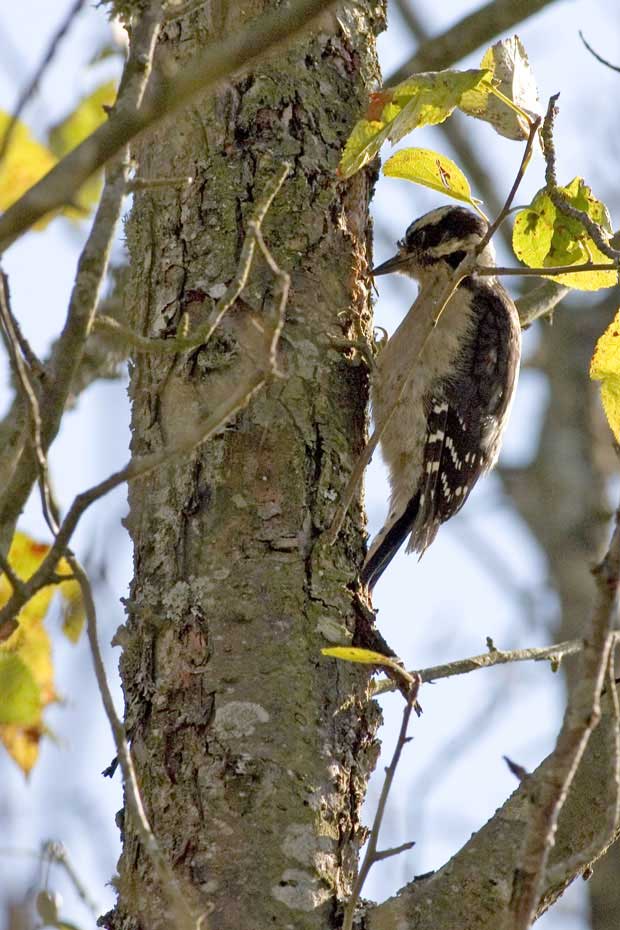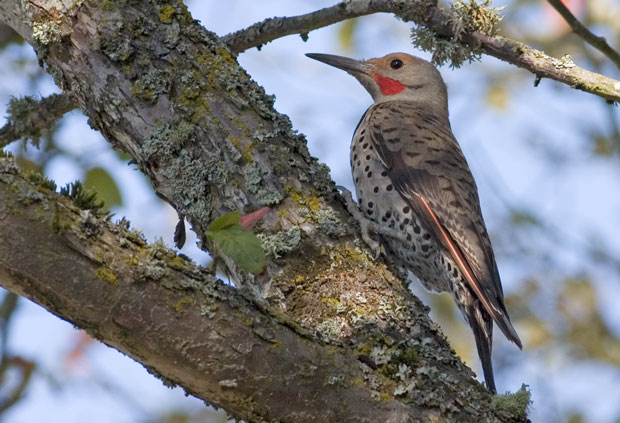It seems a little strange to say that I’m learning “to see” at my age, but in terms of bird watching that’s precisely what I’m trying to do.
If you’re like me, you have birdwatching friends who seem to magically see birds where none exist. Unfortunately, I’m not naturally one of those people.
But I’m trying to become one. Two of my best pictures on my trip to Nisqually last Friday were taken after I’d stopped and paused, listening for bird sounds that might clue me in to nearby birds. I hadn’t paused very long before I heard a tapping noise right over my head.
The first time I got a picture of this small Downy Woodpecker:

or, at least what I’m calling a Downy Woodpecker until one of my more informed visitors tells me otherwise. Sometimes it seems even harder to find a match in the guidebooks for what you’ve seen than it was to see the bird in the first place.
Not more than twenty minutes later I repeated the above scenario, this time resulting in my favorite picture of the day, a Red Shafted Flicker:

I had spotted several of these on previous walks at Pt. Defiance but had never been able to get a decent picture of one.
Judging from last night’s bust at the nature center, though, I’m a long ways from becoming one of those gifted birdwatchers who can make birds appear on command. Despite lots of bird calls, the only birds I saw were some ducks who headed right for us when we crossed the bridge. For some reason, hard-to-see birds are more appealing than those who pursue you to get handouts.

Hi Loren,
Your title, “Learning to See”, caught my eye. I have been a birder for probably twenty years although where I now live, the birds are fairly boring.
However, back to my point. We just went on vacation to Glacier NP in Montana and while we were there i spotted a book on keeping a nature journal.
We live on 10 acres and I had always thought I should at least know the names of all of the trees there. After getting this book I seem to be seeing many things (plants, critters, etc) I had never noticed before as well as developing quite an urge to find out their name as well as their natural history.
The book requires that you draw everything but until I develop that skill, I am using the digital camera as a stopgap. I have bought the colored pencils so will give that a shot pretty soon.
BTW, your opening words referred to your age. I just turned 62 last week and suspect that fact has something to do with my interest; perhaps a fear of running out of time.
Take care and enjoy your learning.
Bob Skinder
Loren–very nice woodpeckers! The only way I’ve ever been able to differentiate between the downy woodpecker and the hairy is that the hairy is more like a large sparrow, the hairy is bigger. Unfortunately, I don’t have a great eye, so when I see one up high or briefly, I often can’t gauge the size.
I can’t say anything as intended in my old age! I was trying to say the downy is smaller, more like a house sparrow.
Thanks, Ron, despite the relative size of the pictures, the flicker was huge compared to the first woodpecker, which led me to believe that it was, indeed, the downy woodpecker, not the hairy woodpecker.
I don’t know why such similar woodpeckers also ended up with basically similar names–it just continued to make it difficult to tell the difference!